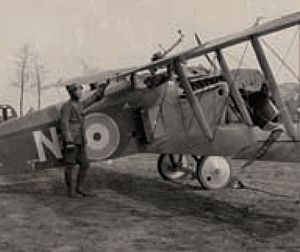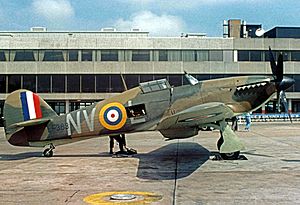No. 79 Squadron RAF facts for kids
Quick facts for kids No. 79 (Madras Presidency) Squadron RAF |
|
|---|---|
| Active | 1 August 1917 (RFC) – 15 July 1919 22 March 1937 – 30 December 1945 15 November 1951 – 1 January 1961 2 January 1967 – 31 August 1992 |
| Country | |
| Branch | |
| Role | Training |
| Nickname(s) | Madras Presidency |
| Motto(s) | Latin: Nil nobis obstare potest ("Nothing can stand against us") |
| Commanders | |
| Notable commanders |
CC McMullen (1939–40) Arthur Clowes (1940–41) |
| Insignia | |
| Squadron Badge | A salamander salient. The salamander is always ready to face any danger. |
| Squadron Roundel |  |
| Squadron Codes | AL (November 1938 – September 1939) NV (September 1939 – March 1942, 1943 – December 1945) T (November 1951 – 1956) |
No. 79 Squadron was a special group of pilots and aircraft in the Royal Air Force (RAF). They flew many different types of planes and took part in important events like World War I and World War II. This squadron was known for its bravery and skill in the skies.
Contents
History of No. 79 Squadron
No. 79 Squadron had a long and interesting history, being formed and reformed several times over the years. Each time, they played a key role in defending the skies or training new pilots.
World War I: Early Days of Flight
The squadron first started on 1 August 1917, during World War I. It was part of the Royal Flying Corps, which later became the RAF. They flew Sopwith Dolphin fighter planes. These planes were used for attacking targets on the ground, helping soldiers on the battlefield.
Even though they focused on ground attacks, the squadron also shot down 64 enemy aircraft and nine observation balloons. Some very skilled pilots, known as "aces" (pilots who shot down five or more enemy aircraft), served with No. 79 Squadron. After the war ended in 1918, the squadron was disbanded on 15 July 1919.
Reforming for World War II
No. 79 Squadron was brought back on 22 March 1937, before World War II began. They first flew Gloster Gauntlet biplanes, which were planes with two sets of wings. Soon after, in November 1938, they received more modern Hawker Hurricane fighters.
Defending Britain in the Battle of Britain
When World War II started, the squadron was ready. They shot down their first enemy plane, a German Dornier Do 17, on 21 November 1939. During the Battle of France, they moved to France for ten days and managed to shoot down 25 German aircraft.
The squadron played an important part in the Battle of Britain, defending the skies over England. They flew from airfields like Biggin Hill and Hawkinge. After intense fighting, they moved to RAF Acklington for a short break before returning to the battle.
Serving in the Far East
In 1942, No. 79 Squadron was sent to the Far East, arriving in India in May. Here, they mostly flew ground attack missions, first with their Hurricane planes. In June 1944, they switched to P-47 Thunderbolt IIs. They continued to support ground troops until the squadron was disbanded in Burma on 30 December 1945.
Post-War and Training Roles
The squadron was reformed again on 15 November 1951. This time, they were a fighter-reconnaissance squadron, meaning they flew missions to gather information and fight if needed. They flew Gloster Meteor FR.9s from West Germany.
In June 1956, they updated their planes to Swift FR.5s. On 1 January 1961, the squadron was renumbered and became part of No. 4 Squadron.
Training Future Pilots
No. 79 Squadron was reformed one last time on 2 January 1967. Their new job was to train pilots to fly the Hawker Hunter aircraft. This training unit was based at RAF Chivenor. Later, they also trained pilots on the Hawker Siddeley Hawk T.1 and BAC Jet Provost T4. The squadron was finally disbanded on 31 August 1992.
See also
- Jimmy Davies, an American-born airman who served in World War II.




